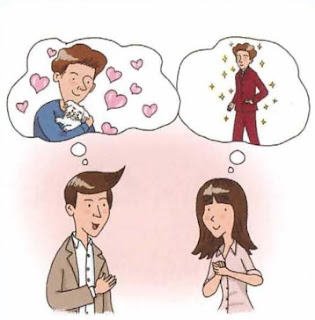가: 태민 씨 생각에 케빈 씨는 어떤 사람인 것 같아요?
Taemin, what do you think about Kevin?
나: 글쎄요. 어른들 말씀에 동물이나 아이들 좋아하는 사람치고 심성이 나쁜 사람은 없다고들 하시잖아요. 강아지를 좋아하는 걸 보면 마음씨가 좋은 사람일 것 같아요.
Well, as the elders say, nobody who likes animals and kids has a bad heart. Seeing that he likes dogs, my guess is that he’s got a good heart.
가: 그렇죠? 보통 금융계에 종사하는 사람들은 약간 냉정하고 치밀해 보이는데 금융인치고 약간 어수룩하면서 마음도 따뜻하고, 정도 많은 것 같고요.
Right? Usually, people who work in the financial industry look a little cold-hearted and meticulous, but considering the fact he’s a financier, he seems naive, warm-hearted, and kind.
나: 어? 이상하네. 소희 씨 혹시 케빈 씨 좋아하는 거 아니에요?
Oh? That’s a bit odd. Could it be that you like Kevin, and Sohee?
1. 치고 attaches to nouns and is used to indicate that something is the case in every instance of that noun. In most cases, either a negative or rhetorical statement follows the expression.
• 남자 아이치고 로봇을 안 좋아하는 아이가 어디 있겠어요?
For a boy at that age, is there any boy who wouldn’t like robots?
• 요즘 대학생치고 취업 스트레스를 받지 않는 사람은 없을 거예요.
For today’s university students, not a single one has experienced the stress associated with job hunting.
2. 치고 attaches to nouns to indicate that the noun is an exceptional example when its general qualities or characteristics are considered. It can be emphasized by adding 는 to the end of 치고.
• 그 선수는 운동선수치고 몸이 너무 왜소해요.
For an athlete, his body is too small.
• 정식 교육을 받지 않은 사람이 그린 그림치고는 굉장히 훌륭하네요.
As a work painted by someone who hasn’t received a formal education, this is very impressive.
The meaning of this expression can also be emphasized by the addition of 서 to form 치고서.
• 요즘 대학생치고서 취업 스트레스를 받지 않는 사람은 없지요.
• 정식 교육을 받지 않은 사람이 그린 그림치고서는 굉장히 훌륭하네요.
>> You can click on the title of each grammar below to see other grammars which also express ‘Situations and Standards’
1. -는 가운데
2. -는 마당에
3. 치고
4. -(으)ㅁ에 따라
>> Full of ‘Korean grammar in use – Intermediate’: Click here
>> Full of ‘Korean grammar in use – Advanced’: Click here
>> Follow my page to get Korean lessons: Say Hi Korean

